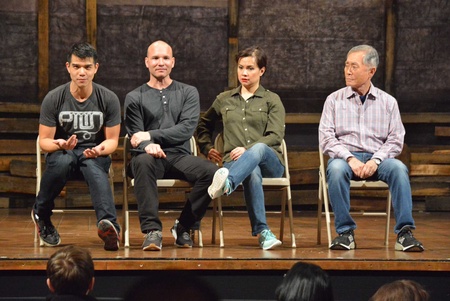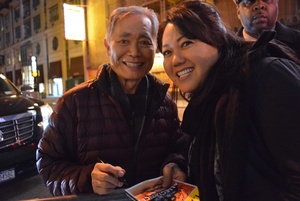After interviewing Takei and thoroughly researching the WWII incarceration, Kuo, Thione, and Marc Acito wrote the book and Kuo composed the music and wrote the lyrics for Allegiance, which debuted in San Diego in 2012. The current Broadway version has evolved since then, with fewer principal roles, different songs, and changes in the script.
“We had to tell the story of not just one camp, but of 10 camps,” said Jay Kuo in an interview. “Not everything that happened in those camps happened at Heart Mountain. But, all the things we portrayed did happen in one of the camps. We had to squeeze a lot of education in the story!”
Kuo admitted that the month-long Broadway preview before the official November opening at the Longacre Theatre was stressful because of ongoing changes made and tested in front of live audiences.
“Sometimes they were learning stuff we gave them that morning, staging it, and then putting it on that night for 800-900 people. We changed all the lyrics to ‘What Makes a Man’ and there was one time Telly went up on all his lines and just made up the entire song completely. A friend said ‘Oh wow, that’s such an interesting choice—there’s so much silence during that song.’ He’s really Japanese that way,’” Kuo laughs now.
As for the songs, an original cast is in the studio this month to release a CD in January, and at the performances currently a “pre-Broadway mini-CD” of some of the songs, including the ensemble focal point “Gaman” and Salonga’s show-stopper “Higher,” is available during the intermission.
Tweaking the music was a constant task, Kuo said. “I rewrote the opening number, I rewrote the finale, I had several rewrites throughout the process. We cut half of one number, and the baseball number was completely revamped. I even wrote two songs to have ready to put in in case they yanked two of the songs. So I have songs that never even saw the light of day.”
One of the major changes since San Diego was the role of the real-life character Mike Masaoka, the national secretary and field director for the Japanese American Citizens League, who urged Japanese Americans to go to the camps as a show of their patriotism, and later to join the US military again, to show their patriotism. Masaoka died in 1991.
In the original musical, the Masaoka character was criticized by JACL and some Japanese Americans. The role has since changed, though JACL still released an announcement when the Broadway version opened, stating its displeasure that the character and JACL were both in the play.
The current version shows Masaoka, played by Greg Watanabe, as a sympathetic character who believed he was doing the best thing for the Japanese American community. At times he’s shown being used by the federal government because of his relationship with the community. But he’s not demonized. “In this iteration I think he was not the villain,” agreed Watanabe in an interview. “I think he made some hard decisions that had heavy duty consequences.
“Mike Masaoka felt fear, and felt he needed to protect as many people as he could,” Watanabe added. He came from the idea of what choice do we have, so we’re going to comply.”
Floyd Mori, a friend of Masaoka and a longtime JACL leader, wrote a positive review and urged his readers to support the show because of the important larger story it tells, even if he didn’t agree with some of the details.
What’s important, said Kuo, is that the story of incarceration is getting a mainstream audience. He was an attorney before going fulltime into show business, and in law school he had studied the history of the camps from a legal perspective.
“So I’d always had a sort of a philosophical, intellectual interest in the question of the internment. What I didn’t know were the personal stories. George was the first person I’d ever met who was actually in a camp. And now, I’ve met hundreds.”
The cast and crew all took seriously the task of researching and understanding what happened in the past.
During the AARP talkback session, Lea Salonga noted, “Our creative team did their due diligence as far as research and passed on so much to every member of the company. Our company management also passed on so much documentation about Heart Mountain, about the internment—stuff that we as actors could then go home and read on our own time in order to put into our bodies and into our heads what this experience must have been like. Everyone on this production did their homework.”

Leung said during the talkback that he didn’t know that much about those years before taking on the role. “I’m Chinese American, so learning about Japanese and Japanese American culture was something new to me.”
But he especially credited Takei for helping “train” him as a Japanese American. “The first resource I have is George who actually lived through the experience. So as an actor, it’s so useful to ask George all those sensory things: what did it look like, what did it smell like, what did it taste like?—all those things that are my actor tools when I’m up here that are sensory. Yes, you can read about internment in books as well, but for actors, that’s what’s useful.”
“George has such vivid memories,” Leung said, “even down to I remember one day, he said, ‘my father wouldn’t have worn a hat like that.’ A lot of our cast members are also of Japanese descent so a lot of times they were also wonderful resources for me as well.”

Salong explained that her husband is half-Chinese American and half-Japanese American, and “he was raised more exposed to the Japanese side of his heritage. And he has uncles who have served on the 442nd—two of them. He himself says that it was an experience that my family never spoke about. They never talked about the internment. I think a lot of what Allegiance is putting up on the stage is brand-new information even to him.”
Takei emphatically stated that’s why it’s so important to produce this play, and to ensure its success so many more people can see it and learn about the chapter of American history.
“Even for many younger Japanese Americans this is a brand-new story,” he said. “I discovered this after our San Diego run. These young Japanese Americans came backstage and told me that they knew that dad and mom, or grandpa and grandma, were in camps. That’s all they knew because they never talked about it. They were so pained, wounded, shamed by that experience that they didn’t share it with their children.
“For many younger Japanese Americans, seeing Allegiance was the first time they learned about the Loyalty Questionnaire, to be challenged on our loyalty, a year into prison. Outrageous. We’re Americans! My mother was born in Sacramento. My father was in San Francisco. They met and married and had us in Los Angeles. We’re Americans. And for the government to presume that just because of our faces, we had an inborn, genetic loyalty to the Emperor, was insulting.”
The parallels to the level of racial tension and fear of foreigners that is boiling over now is obvious to Takei—and this performance and talkback happened days before the Paris attack, and weeks before the San Bernardino shootings.
“This story is so important, because it’s so relevant to our times today, where in our presidential nominating campaign, we have candidates who with a broad brush, paints all immigrants coming from south of the border, as criminals and rapists. We have the issue of Black Lives Matter, where young men, who happen to be African American, are seen as threatening to law enforcement officers and they could be shot at with impunity. It is a very relevant story, when a whole race of people are just assumed to be enemies.”
His hope, Takei said, is that Allegiance “starts off a lot of other conversations about this chapter of American history.”
And, makes audiences think about how its lessons can be applied today.
Allegiance is playing at the Longacre Theatre on Broadway in New York City, allegiancemusical.com.
The Allegiance website is a treasure-trove of information about the musical and the history of the Japanese American incarceration, as well as the history of the musical itself. You can see a fascinating nine-part documentary about the evolution of the musical and its journey from San Diego to Broadway. Start here with Episode #1.
Here’s a mix of YouTube videos from Allegiance, starting with Lea Salonga’s show-stopping solo ballad “Higher,” and including several videos of the “Allegiance cast hamming it up with Broadway hitmaker Lin-Manuel Miranda of Hamilton:
*This article was originally published on Nikkei View, on December 7, 2015.
© 2015 Gil Asakawa







